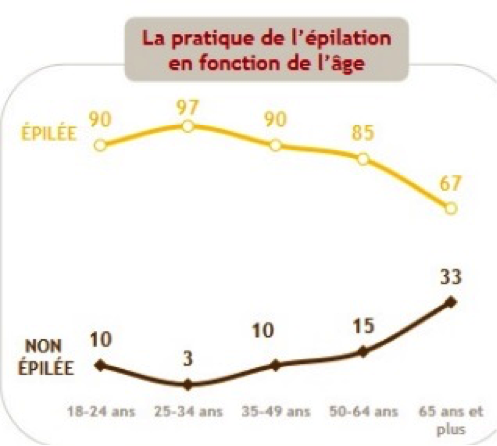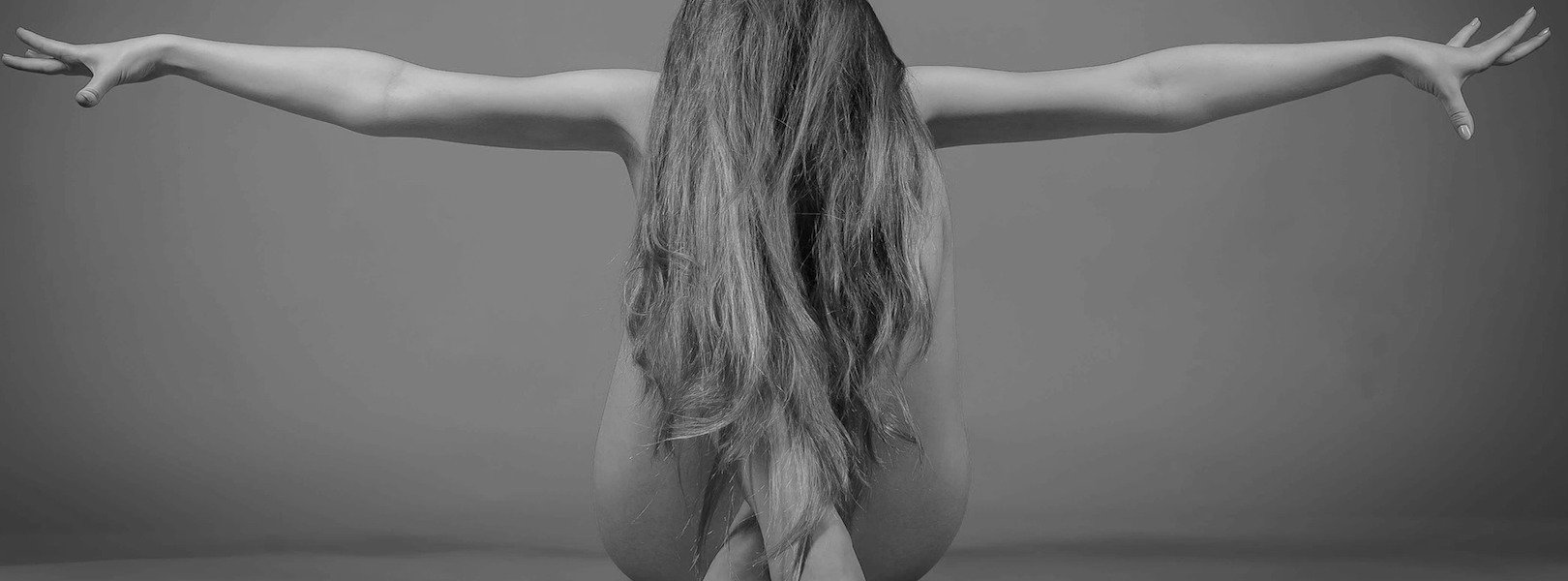To learn more about Les 3 sex*'s editorial policy and text selection, click here.
☛ Cette chronique est aussi disponible en français [➦]
Translated by Zoe Yarymowich
As seen in part I of this article, hair and the control over it are linked to the history of the West. Alternating between periods of relaxation of the norm and the eroticization of hair (Giard, 2017) with other more strict periods on the subject, current societies are characterized by smooth bodies where hair has no place. While some people denounced the standard of hairlessness as a consequence of patriarchal domination (Megaconnard, 2012), others, such as the women interviewed for this article, claim the choice to shave. The rejection or acceptance of hair is therefore socially constructed (Auzépie & Cornette, 2011). It remains to be seen to what extent individuals are conditioned by the norm and also to understand how much leeway they have when faced with it.
Questioning the Patriarchy
Are individuals who remove their pubic hair subject to patriarchal standards? I do not think so.
Because wanting to change a norm (hair removal) for another (not removing hair) does not destroy the norm, it inverses it.
The return to not removing one’s hair can be explained, in my opinion, by two reasons: on one hand, as was seen, by questioning gender injunctions - particularly concerning women - but also by returning to a certain form of nature. Faced with a capitalist society accused of smoothing out the differences between individuals and promoting a sanitized world (Gasnier, 2017), we are witnessing a return to the “natural” with the emergence, for example, of new products, stamped with the “organic” certification or the tendencies to encourage individuals to “find themselves” by confronting their subjectivity to nature (Chanvallon et Héas, 2011). In doing so, part of the discussion on the issue of hair removal takes the form of debates on the opposition between nature and nurture, either between what would be innate - therefore considered as an immutable and timeless element - and acquired, or an element coming to disturb the deep nature of the individuals. As a comment in an article related to hair removal points out “I do not remove any hairs from any part of my body and for a reason, I recognize my link with nature, and harmony goes through that, it’s awful having to specify this because it’s absolutely obvious.” (Portail de la Mode, 2016, translated from French). It is seen here that the standard of hair removal - referring to culture - being called into question in favour of the recognition of an obvious link with nature, a sine qua non of a balance with it. The opposition to the norm, considered artificial and too restrictive, is therefore done in favour of a more natural state and is, in my analysis of this person's testimony, more authentic.
The influence of some feminists is also not to be forgotten. The Mouvement International pour une Ecologie Libidinale (MIEL) is developing, like several other feminist groups and associations, a long argument in favor of the fight against hair removal. The main argument would come from the latter referring to a de-eroticization of the body and a desexualization of women, consequences of a patriarchal system seeking to control women’s bodies through all means by setting up oppressive models (MIEL, n.d.).
A Less Strict Norm Than it Seems
As was seen in part I, there is indeed an incentive for hair removal, one that predominantly affects women and to a lesser extent, men (Levenson, 2016). However, the study of daily practices indicates a more nuanced reality. According to the Yougov study (Mazaurette, 2016b), hair removal is not an obligation for everyone, with respectively 50% of respondents unsure whether men should shave, and 20% for women. Thus, these figures show, if not a minority liable to question the majority, a part of the population liable to potentially juggle with the norm. The Institut français d'opinion publique (IFOP; 2014) study sheds light on the most interesting statistical aspect: what people who are affected by the norm do via hair removal practices.

As shown here, hair removal practices gradually decline with age, although the percentage of women who resort to hair removal remains higher than that of women who do not. What should one deduce from this? While hair removal is the norm, this tendency progressively declines with age. The study highlights a generational factor, with younger people waxing more than older people. In doing so, the aesthetic of intimate hair removal changes over time. As Jacques André notes, “Bikini waxes, landing strips, [and] Brazilians are the classics of the day” (André, 2011, translated from French). However, on the spectrum between non-epilation and Brazilian waxes hides several other situations. The IFOP study also reveals a wide variety of hair removal methods. In response to the question: “Personally, what form of intimate hair removal do you use most often?”, only 14% of women over the age of 18 reported a Brazilian wax, while 33% responded “the classic bikini wax” and 15% said that they did not remove their pubic hair at all. In addition, the study also indicates that correlations exist between the sociodemographic data and hair removal. For example, the most educated people wax less, while homosexual or bisexual women shave more than heterosexual women with 37% compared to 12% respectively. The number of partners an individual has also had an influence, as only 6% of women who have had only one partner or no partner in their lifetime remove their pubic hair, compared to 19% for those who have had more than ten partners; likewise, their religious affiliation also influences the data with 32% of atheist women reporting that they do Brazilian waxes versus 2% of practicing Catholics. The IFOP study also indicates differences between what men prefer as a form of intimate hair removal in their partner and the actual practices of women. Thus, 23% of them prefer that they do not remove their pubic hair, 45% prefer hair removal that ranges from classic bikini wax (13%) to landing strip (10%), and only 26% prefer Brazilian wax. Finally, note the lack of serious scientific studies on male intimate hair removal. A study conducted by the company Gillette (Risselet, 2015) indicates that 38% of men interviewed shave their groin. Why? The question remains unanswered, but their responses should clarify the situation.
From the Norm to Learning About the Diversity of Practices
As the work by Marie-France Auzépie and Joël Cornette (Auzépie & Cornette, 2011) indicates, the aestheticization or even the politicization of hair varies greatly from one era to another. Moreover, as Maïa Mazaurette reminds us and several commentators in one of her articles, “every society generates its erotic” (Mazaurette, 2008, translated from French). In addition, given my studies on different topics, it has seemed to me on several occasions that individuals, although they are sensitive and influenced by the norm, they have wiggle room and certain reflexivity.
The latter adapt to it, question it constantly, and seem to adapt more to it as they age, whereas they are subjected to it more strongly during their youth.
Hair removal is no exception to my observations. Some prefer hairless genitals while others abhor them, others use hair removal as an erotic game between partners, a kind of foreplay allowing a form of intimacy to be established. Several women interviewed for this article said that they do not always wax, but use the technique as a ritual before a date to feel confident or desirable. The rest of the time, hair removal isn’t what worries them the most. Some even reported removing their hair, anticipating male expectations, until their partners admitted that they preferred hair. These testimonies show a certain form of flexibility in the way we approach this injunction.
If our time is characterized by a certain norm of hair removal, the latter is not as absolute and sees constant adjustments on the part of individuals in their daily practices.
Some organizations are engaging in actions aimed at reminding young people in particular, because they are more sensitive to the norm, that neither men nor women have to remove their pubic hair if they do not want to, but that they do have the option to do so (Pellissier, 2013). This raises the question of consent and intimate education, unfortunately, neglected by public authorities. It is gratifying that some refuse to remove their pubic hair, just as the reverse should not be met with opposition. The question of the fight against standardization (Rose, 2010) through other practices or bodily representations is necessary, as the testimonies of some women in opposition to hair removal show. While these testimonies are in the minority, they allow the dissemination of ideas fueling the reflections of individuals about this standard and allows them to decide whether or not they will undergo it, and if so, how.
The question of the norm and its internalization, whether it concerns hair removal or any other subject relating to the intimate, must challenge us in ways that allow individuals to live their lives in the way they intend.
The younger generations are currently evolving in societies where competition and performance are dominant values. In this context, hair removal takes on an imperative character for them, participating in a pure and smooth self-presentation. Informing them of the possibilities that are available to them, whether it concerns full hair removal or not, all with respect for everyone seems more relevant to me than a heated and divisive debate on what individuals should or should not do.
To cite this article :
Dusseau, F. (2018, January 30). Intimate Hair Removal: Between Norms and Arrangements (Part II). Les 3 sex*. https://les3sex.com/en/news/12/article-l-epilation-intime-entre-norme-et-arrangements-part-ii-

Comments